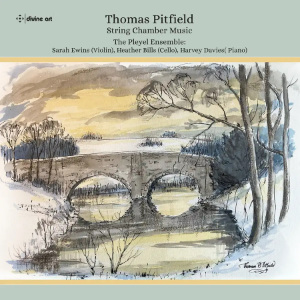
Thomas Pitfield (1903-1999)
Piano Trio No 1 in C major (1930)
Piano Trio No 2 in F minor Lyric (1948/1949)
Epigraph for violin, cello and piano (undated)
Sonatina for cello and piano (1955)
Sonata in D minor for cello and piano (1937/1938, publ. 1949)
The Pleyel Ensemble
rec. 2023, Carole Nash Recital Room, Royal Northern College of Music, Manchester, UK
Divine Art DDX21137 [61]
A critic once told me that George Butterworth was a composer who never wrote a piece of music that was unattractive; the same verdict may well apply to Thomas Pitfield, as well. I have been immersing myself in his music over the last few days and have found every piece I encountered to be beautiful, interesting and fastidious in craftsmanship. I think the time really has come for Pitfield’s music; once unfairly passed over for being unfashionably melodious and traditional, the wheel has now come full circle and his positive qualities can be appreciated by audiences new to his compositions. It seems extraordinary to me that much of this engaging music has lain forgotten for decades.
The Piano Trio No. 1 is, for me, the highlight of this disc. I appreciate its emotional directness, its emphasis on melody and its appealing and subtle harmonies. In each of the three movements, the listener feels that not a note is wasted, with textures beautifully wrought, so that clarity and warmth are both maximised. It is an extraordinary piece, which seems to pack a huge amount of interest into a relatively small time span (sixteen-and-a-half minutes). The first movement charms the listener from the opening bar and skilfully combines English and French stylistic features; Pitfield may possibly have used the piano trios of Moeran and Ravel as points of departure. The second movement is, if anything, even more rewarding; the profusion of striking melodies is certainly a notable feature of this work. The finale rounds off this immensely lovable piece in compelling fashion.
The second Piano Trio is far more challenging than the first. I was a little puzzled by the moniker “Lyric”. This is undoubtedly an important work, but listeners need to hear it several times before its many strengths are fully grasped. I like the slightly acerbic feeling of the first movement, as different ideas seem to be colliding into each other, jostling for the listener’s attention. The second movement, marked “Larghetto solenne”, is perhaps the finest part of this trio, with its quirky and unexpected central section. The finale resumes the tense mood of the opening. It is interesting to hear echoes of Arnold Bax here; one passage (from 3:44) reminds me a little of Bax’s strident, yet magnificent “Saga Fragment”. Throughout this movement, the momentum scarcely flags until the final bars, which unexpectedly close the work in a tranquil mood.
The Epigraph for violin, cello and piano is an attractive miniature that is full of disarming simplicity. A critic might complain that it is a little too short; like Oliver Twist, I feel that I want more here. This is surely preferable, however, to a piece that outstays its welcome.
I love the Cello Sonatina of 1955; this eleven-minute work is a real winner. In the first movement an unexpected musical influence seems to creep in (from 1:33) – Constant Lambert! One interesting feature of this disc is how each piece is so different. I have noticed that Thomas Pitfield never repeats himself – he appears to have an inexhaustible range of moods at his disposal. The lyrical second movement has an enchanting, bittersweet quality. This is English melancholy in its truest sense, that glorious fusion of sadness and beauty, when “our sweetest songs are those that tell of saddest thought.” Pitfield’s idea of melancholy is certainly not the same as Birtwistle’s, which is more akin to the misery one feels when our rubbish isn’t collected on time.
The substantial Cello Sonata is the final item on this disc. It is another major discovery and an important addition to the repertoire. The writing for the cello is extremely fine, which is not unexpected, as this was Thomas Pitfield’s own instrument. I feel that the piano writing is rather big-boned, however, but the composer skilfully balances his textures so that the cello is never drowned out. This is an imposing piece that combines lyricism and drama in equal measure.
Throughout this disc, the sound is excellent and the performances are exceptionally alert and sensitive. The booklet notes are also interesting and informative. I very much like the cover image, which is a watercolour by the composer of “Weaver Bridge at Church Minshull, Cheshire”. Thomas Pitfield was certainly an extremely talented artist, as well as composer. The artwork seen here is firmly in the English watercolour tradition of John Varley (1778-1842), with trees elegantly framing the picture, the water in the centre and a Romantic sky.
There can be no doubt that this is a first-rate disc and I welcome it with much enthusiasm. This new recording should help to advance Thomas Pitfield’s fast-growing reputation and hopefully lead to many more performances of music by this rewarding composer.
David Jennings
www.davidjenningscomposer.co.uk
Previous reviews: John France (August 2024) ~ William Kreindler (September 2024)
Buying this recording via a link below generates revenue for MWI and helps us keep free access to the site




















